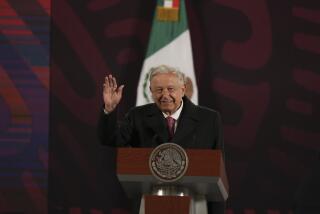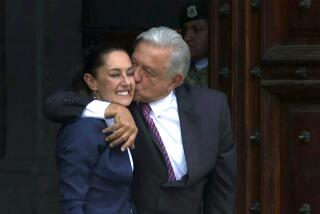Comandantes Remain in Control of Sandinista Party : Nicaragua: Ortega and others of the old National Directorate are confirmed. Women are shut out, at least for now.
MANAGUA, Nicaragua — The comandantes who led the Sandinistas to victory as guerrillas in 1979 and to defeat as a government in 1990 have retained control of Nicaragua’s largest political movement, surviving the first stirrings of democracy within its ranks.
Ending the first party congress of its 30-year history Sunday night, the Sandinista National Liberation Front also reaffirmed the ideal of Marxist-inspired socialism but renounced terrorism and promised to struggle for power by peaceful means.
The three-day congress, attended by a gamut of sympathizers, from the Palestine Liberation Organization to the French Socialist Party, was a pivotal event in Nicaragua. The Sandinistas, who control the army and key trade unions, can still make or break national stability, but their public debate left the balance between oppositionists and those favoring cooperation with the new government unclear.
Former President Daniel Ortega, landslide loser of last year’s national election and a man with a leg in each camp, was named secretary general of the party. The 580 elected delegates also chose Henry Ruiz, who was expelled from a Moscow university before supervising the Sandinista government’s early economic failures, to be party treasurer.
Ortega, Ruiz and all five other members of the self-appointed National Directorate nominated themselves for election as a group and were confirmed, along with two party insiders added to the slate--former Vice President Sergio Ramirez and Rene Nunez, the directorate’s non-voting secretary.
By a 480-to-60 vote, the delegates defeated a reformist bid by the Sandinista Youth organization to force the comandantes to compete individually on an open ballot with other candidates, including women. Heeding a call by Ortega to keep the all-male directorate intact for now, they accepted the official ticket without opposition.
The big loser in this battle was Dora Maria Tellez, 35, an exemplary Sandinista guerrilla fighter, health minister and legislator who was the top female candidate for leadership. To the dismay of women delegates, she was rejected from the official slate, apparently because of her strong reformist views.
“The comandantes talk a lot about their efforts to promote women’s rights, but you don’t see the results,” said congress delegate Milu Vargas.
Reformers did manage to dilute the comandantes’ supreme authority by making the directorate answerable at twice-yearly meetings to the Sandinista Assembly, an informal sounding board until now, and to party congresses held every four years. Then, in the closest thing to a democratic shake-up, delegates chose a new assembly, reelecting 33 members of the “historic” one that was chosen secretly in the 1970s and casting 39 others out.
Among those ousted were Rosario Murillo, Ortega’s wife, who had alienated many Sandinistas as an arbiter of revolutionary culture.
But the elections gave no hint of Sandinismo’s direction because leading reformers such as Reynaldo Antonio Tefel and Edmundo Jarquin, who want a more democratic and less violent party, were defeated along with hard-liners.
“This election is a new experience for Sandinismo and will enrich our history,” Ortega told delegates. He promised reformers that the ballot for a new directorate would be open in 1995 and include women, who made up 17% of the delegates elected by grass-roots party caucuses.
Besides being mostly male, the congress indicated that the party, led in its guerrilla days by men in their 20s and early 30s, is growing old. Despite intense Sandinista recruiting in the schools during the revolution, just 5% of the delegates were 25 or younger, and a quarter of them were over 40.
Judging from the shiny Toyota Land Cruisers, Mitsubishi Monteros and Mercedes-Benzes in the convention center parking lot, the Sandinistas are also wealthier--a sore point in Nicaragua today.
In rejecting a change at the top, Sandinista leaders warned that divisions might undermine “revolutionary conquests”--including the comandantes’ own mansions as well as property seized for thousands of poor people--that are under attack by conservatives in President Violeta Barrios de Chamorro’s government.
“There’d be anarchy,” Ortega predicted.
Reformers, falling into step with the theme of Sandinista unity, bowed to the majority. “We thought a democratic vote would strengthen the leadership, but we were misinterpreted,” said William Flores, author of the open-ballot proposal. “The old Sandinista Front has to be abandoned little by little.”
Tension between Sandinistas’ democratic aspirations and militarist roots showed in other ways. The congress proclaimed the party a “vanguard that applies Marxist-Leninist principles creatively” and aspires to “the most noble ideals of socialism.” But it criticized the misguided statist policies and authoritarian behavior of Sandinista government officials that fed the Contra insurgency and cost the election.
Antonio Lacayo, Chamorro’s top aide, spoke to the congress and congratulated its “commitment to peace and reconstruction.” But hard-liners refused to applaud him. And the party proclamation carried a warning: Peace will fail if “reactionary capitalists” trample working-class interests.
“Sandinista leaders continue to maintain a double standard, cooperating with the government on the one hand and fomenting labor unrest on the other,” said party reformer Rafael Solis. “They refuse to define themselves because they’re afraid of division.”
More to Read
Sign up for Essential California
The most important California stories and recommendations in your inbox every morning.
You may occasionally receive promotional content from the Los Angeles Times.









